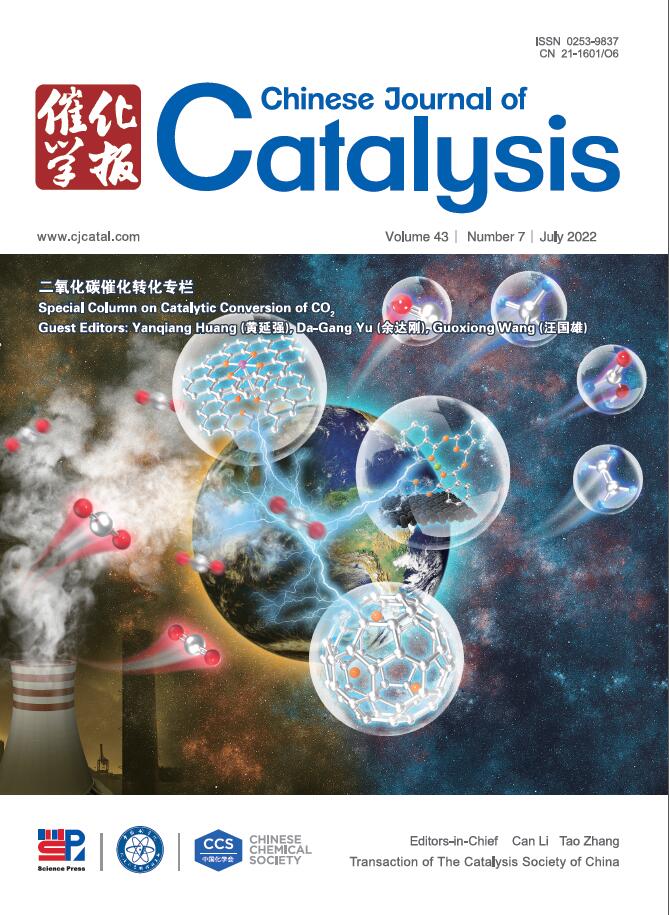Engineering spin polarization of encaging Co nanoparticles in atomic CoNx sites evoke high valent Co species for boosting organic compound oxidation
IF 17.7
1区 化学
Q1 CHEMISTRY, APPLIED
引用次数: 0
Abstract
Precise manipulation of the catalytic spin configuration and delineation of the relationship between spin related properties and oxidation pathways remain significant challenges in Fenton-like processes. Herein, encapsulated cobalt nanoparticles and cobalt-nitrogen-doped carbon moieties, endowed with confinement effects and variations in shell curvature were constructed via straightforward pyrolysis strategies, inducing alterations in magnetic anisotropy, electronic energy levels and spin polarization. The enhanced spin polarization at cobalt sites leads to a reduction in crystal field splitting energy and an increase in electronic spin density. This phenomenon facilitated electron transfer from cobalt orbitals to pz orbitals of oxygen species within peroxymonosulfate molecules, thereby promoting the formation of high-valent cobalt species. The encapsulation effectively stabilized cobalt nanoparticles, mitigating their dissolution or deactivation during reactions, which in turn enhances stability and durability in continuous flow processes. The high-valent cobalt species within the shell exhibit increased exposure and generate localized high concentrations, thereby intensifying interactions with migrating pollutants and enabling efficient and selective oxidation of emerging compounds with elevated redox potentials. This work underscores the profound impact of confined encapsulation curvature and spin polarization characteristics of metal sites on catalytic oxidation pathways and performance, opening novel avenues for spin engineering in practical environmental catalysis.
工程自旋极化包裹Co纳米粒子在原子的凸位激发高价Co,促进有机化合物氧化
在类芬顿过程中,精确操纵催化自旋构型以及描述自旋相关性质与氧化途径之间的关系仍然是重大挑战。本文通过简单的热解策略,构建了具有约束效应和壳曲率变化的封装钴纳米粒子和钴氮掺杂碳部分,引起了磁性各向异性、电子能级和自旋极化的变化。钴位自旋极化的增强导致晶体场分裂能的降低和电子自旋密度的增加。这一现象促进了过氧单硫酸盐分子内电子从钴轨道转移到氧的pz轨道,从而促进了高价钴的形成。包封有效地稳定了钴纳米颗粒,减轻了它们在反应过程中的溶解或失活,从而提高了连续流动过程中的稳定性和耐久性。壳内的高价钴表现出增加的暴露并产生局部高浓度,从而加强与迁移污染物的相互作用,并使氧化还原电位升高的新化合物能够有效和选择性地氧化。这项工作强调了金属位点的封闭封装曲率和自旋极化特性对催化氧化途径和性能的深远影响,为自旋工程在实际环境催化中的应用开辟了新的途径。
本文章由计算机程序翻译,如有差异,请以英文原文为准。
求助全文
约1分钟内获得全文
求助全文
来源期刊

Chinese Journal of Catalysis
工程技术-工程:化工
CiteScore
25.80
自引率
10.30%
发文量
235
审稿时长
1.2 months
期刊介绍:
The journal covers a broad scope, encompassing new trends in catalysis for applications in energy production, environmental protection, and the preparation of materials, petroleum chemicals, and fine chemicals. It explores the scientific foundation for preparing and activating catalysts of commercial interest, emphasizing representative models.The focus includes spectroscopic methods for structural characterization, especially in situ techniques, as well as new theoretical methods with practical impact in catalysis and catalytic reactions.The journal delves into the relationship between homogeneous and heterogeneous catalysis and includes theoretical studies on the structure and reactivity of catalysts.Additionally, contributions on photocatalysis, biocatalysis, surface science, and catalysis-related chemical kinetics are welcomed.
 求助内容:
求助内容: 应助结果提醒方式:
应助结果提醒方式:


